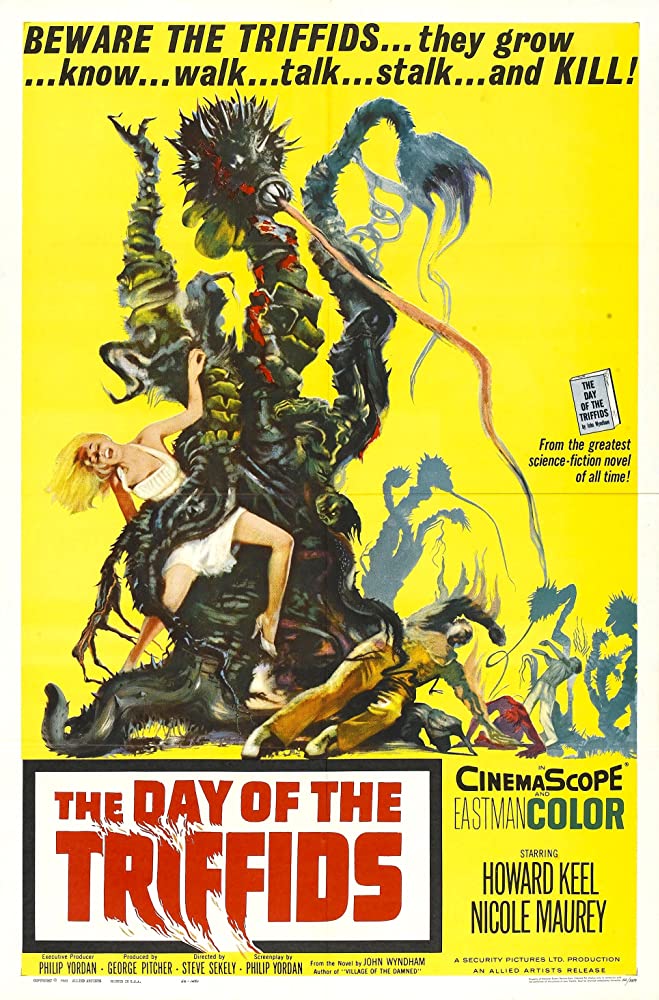Previous FilmDay of the Animals
Next FilmDay The World Ended
Day Of The Triffids 1962
 | After an unusual meteor shower leaves most of the human population blind, a merchant navy officer must find a way to conquer tall, aggressive plants which are feeding on people and animals. |
The Cast
| Howard Keel | - | Bill Masen |
| Nicole Maurey | - | Christine Durrant |
| Janette Scott | - | Karen Goodwin |
| Kieron Moore | - | Tom Goodwin |
| Mervyn Johns | - | Mr. Coker |
| Ewan Roberts | - | Dr. Soames |
| Alison Leggatt | - | Miss Coker |
| Geoffrey Matthews | - | Luis de la Vega |
Film Trivia
Kieron Moore and Janette Scott were only added to the cast when it was discovered up on completion of filming that there was only 57 minutes of good usable footage available. The whole lighthouse sequence, directed by veteran Director of Photography Freddie Francis, was only added to help extend the movie's running time.
The triffids inspired the E.T. plants of E.T. the Extra-Terrestrial (1982)
In an interview, producer Bernard Glasser said that in order to satisfy a British government requirement that productions shot in Britain have a certain percentage of British executives, George Pitcher, a retired film executive, was hired as basically a "frontman"; although credited as producer, he had no actual authority over the production.
Although credited with "additional music", composer Johnny Douglas actually supplied more music than the main composer, Ron Goodwin. According to the official music cue sheets, Douglas wrote 26 minutes, Goodwin 19.
Although delighted to be reunited with Howard Keel (whom she had met as a child), Carole Ann Ford found the film difficult to work on, citing last-minute script revisions and changes of director as particular problems. She also suffered when an action sequence left her back accidentally raked by a stuntman's nails, drawing blood.
The American naval base in southern Spain referenced by Bill Masen is real. It's called Rota Naval Station, but it's not in Cadiz' it's actually across the Bay of Cadiz, in the little town of Rota. It's a Spanish naval base, leased by the Americans.
The book ends with the Triffids still a threat and Masen leaving for the Isle of Wight, hoping to eradicate them from the face of the Earth someday.
The novel, published by Penguin Books, sold over a million copies by 1981. It's been translated into several languages. John Wyndham wrote the novel in 1951; by 1981 it had been reprinted 34 times.
In the book, the Triffids grow to more than seven feet tall with the main body a foot clear off the ground. In temperate climates, they can grow to ten feet.
In the book Masen writes up his experiences in a journal.
In the scene where Bill Masen and Mr. Coker are standing outside the house in France, they see an aircraft flying overhead that sounds like it has a sputtering engine. The aircraft shown flying is a silver De Havilland Canada DHC-1 Chipmunk, a primary trainer monoplane. When the two hear the aircraft crash they go to the crash site and find the dismantled remains of a De Havilland DH82A Tiger Moth Reg. G-AJOA a primary trainer bi-plane with its top wing removed. Tiger Moth G- AJOA still exists but has not flown since 2003.
In the book, we don't know William Masen's name or see another person until p;age 17.
A Triffid can survive even if you shoot the top of it off.
They were called Triffids because they had a three-pronged root. Their stems can't be snapped but they can be mangled.
Triffids are extremely vulnerable to fire and will retreat from it; they stand their ground against gunfire because they don't know where it's coming from.
In the book, the Triffids can walk in places like Borneo, Sumatra, the Belgian Congo, Colombia, Brazil, Ecuador and near the equator. When they walked, Masen said it was like "watching a man on crutches". Two of the legs slid bluntly forward, the Triffid then lurched forward with a rear leg drawing level and then the front two legs sliding forwards. As it moved, its long stem whipped violently back and forth; Masen felt seasick just watching. It was both strenuous and clumsy, like young elephants at play. It would probably lose all its leaves and break its stem after a while but it persisted at trying to cover an average walking pace, even if it was ungainly, but the fact that they could walk made headlines. Even tethered by chains, the Triffids could get loose but they avoid hard surfaces because it was uncomfortable for their roots, which were more like limbs. Triffids only ambush people in soft earth to dig their roots while they wait, so they would never ambush someone in the street, only if they were near a garden wall or fence.
Rumors have circulated for years that the odd gurgling noise made by the triffids was a sound effect achieved by smoking a "bong".
The book was an influence on 28 Days Later... (2002) such as scenes with Bill Masen/Jim waking up in hospital; the line "I love you very much"; both the book and the film describe how each mutual disaster has spread to Paris and New York; sending out a signal to fellow survivors, etc. In the book, Masen looks at the now-deserted Houses of Parliament and there's a similar scene in 2"8 Days Later..."; after Jim has woken up from his coma. At the end of the film Jim, Selena and Hannah make a sign to attract an airplane, an idea suggested with a plane or a helicopter at the end of "The Day of the Triffids".